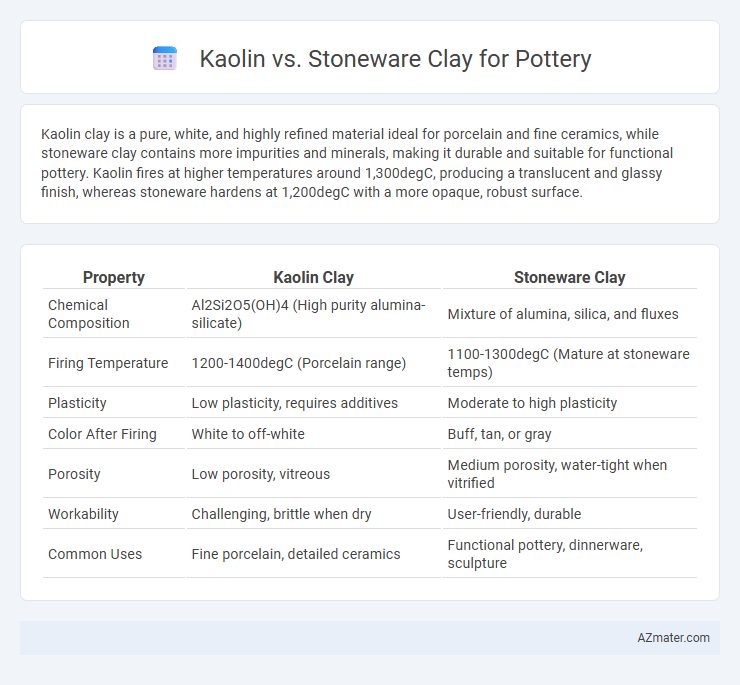Kaolin clay is a pure, white, and highly refined material ideal for porcelain and fine ceramics, while stoneware clay contains more impurities and minerals, making it durable and suitable for functional pottery. Kaolin fires at higher temperatures around 1,300degC, producing a translucent and glassy finish, whereas stoneware hardens at 1,200degC with a more opaque, robust surface.
Table of Comparison
| Property | Kaolin Clay | Stoneware Clay |
|---|---|---|
| Chemical Composition | Al2Si2O5(OH)4 (High purity alumina-silicate) | Mixture of alumina, silica, and fluxes |
| Firing Temperature | 1200-1400degC (Porcelain range) | 1100-1300degC (Mature at stoneware temps) |
| Plasticity | Low plasticity, requires additives | Moderate to high plasticity |
| Color After Firing | White to off-white | Buff, tan, or gray |
| Porosity | Low porosity, vitreous | Medium porosity, water-tight when vitrified |
| Workability | Challenging, brittle when dry | User-friendly, durable |
| Common Uses | Fine porcelain, detailed ceramics | Functional pottery, dinnerware, sculpture |
Introduction to Kaolin and Stoneware Clay
Kaolin is a pure, white clay known for its fine particle size and high refractory properties, making it ideal for porcelain and delicate ceramics. Stoneware clay contains a mix of minerals and is denser, offering durability and strength, which suits functional pottery like dinnerware and cookware. Understanding the distinct plasticity, firing temperatures, and color outcomes of kaolin and stoneware clay helps potters choose the right material for their specific ceramic projects.
Composition and Mineral Content
Kaolin, primarily composed of the mineral kaolinite, is a pure, white-fired clay known for its fine particle size and low iron content, resulting in a smooth texture and high firing temperature capabilities. Stoneware clay contains a mixture of minerals including quartz, feldspar, and varying amounts of iron oxide, which contribute to its durability, plasticity, and characteristic earthy tones after firing. The higher alumina content in kaolin provides greater refractory strength, whereas stoneware's diverse mineral composition enhances its versatility and strength for functional pottery.
Plasticity and Workability
Kaolin clay exhibits low plasticity, making it less workable and more challenging to shape compared to stoneware clay, which boasts higher plasticity and superior malleability for pottery. Stoneware's balanced plasticity allows it to retain shape during forming and resist cracking, ideal for both wheel throwing and handbuilding. The high-kaolin content in porcelain reduces plasticity, requiring advanced skill for manipulation, while stoneware's mineral composition provides a forgiving texture suitable for beginners and versatile pottery techniques.
Firing Temperatures and Maturity
Kaolin typically matures at higher firing temperatures ranging from cone 10 to cone 12 (approx. 2345degC to 2381degC), resulting in a pure, white, and vitrified porcelain body ideal for fine pottery. Stoneware clay matures at slightly lower temperatures, usually between cone 5 and cone 10 (approx. 2167degC to 2345degC), producing a dense, durable ceramic body with varying color and texture based on mineral content. The maturity of kaolin demands precise kiln control to achieve translucency and strength, whereas stoneware offers more firing flexibility without compromising functional toughness.
Color and Surface Texture
Kaolin clay offers a pure white color and a smooth, fine surface texture, ideal for creating delicate porcelain with a translucent finish. Stoneware clay typically presents earthy tones ranging from brown to gray and features a coarser texture that contributes to a more rustic, durable appearance. The color and surface texture differences between kaolin and stoneware clays significantly affect the aesthetic and functional qualities of pottery pieces.
Strength and Durability
Kaolin, known for its high purity and whiteness, produces pottery that is less porous but more brittle compared to stoneware clay. Stoneware clay offers superior strength and durability due to its dense, vitrified body, making it ideal for functional pottery subjected to daily use. The higher firing temperature of stoneware enhances its toughness, whereas kaolin requires careful handling to prevent chipping and cracking.
Water Absorption and Porosity
Kaolin clay exhibits low water absorption and minimal porosity due to its fine particle size and high purity, making it ideal for porcelain and fine ceramics. Stoneware clay has higher porosity and moderate water absorption after firing, which contributes to its durability and resistance to water when properly glazed. The choice between kaolin and stoneware clay depends on the desired balance between strength, translucency, and moisture resistance in pottery.
Glazing Compatibility
Kaolin clay offers excellent glazing compatibility due to its high purity and smooth texture, allowing glazes to adhere evenly and produce vibrant finishes. Stoneware clay, with its higher iron content and grog, can result in more varied glaze responses, often yielding rustic or textured surfaces. Understanding the differences in firing temperatures and surface absorption rates between kaolin and stoneware clay is essential for achieving desired glaze effects in pottery.
Best Uses and Applications in Pottery
Kaolin clay, known for its purity and whiteness, is ideal for fine porcelain, delicate ceramics, and detailed sculptural work due to its smooth texture and high firing temperature. Stoneware clay, with its durability and plasticity, suits functional pottery such as mugs, bowls, and plates that require strength and resistance to chipping. Potters choose kaolin for refined, translucent pieces and stoneware for everyday, robust tableware.
Choosing the Right Clay for Your Pottery Project
Kaolin offers a pure, white finish with high plasticity, making it ideal for fine, delicate pottery and porcelain projects, while stoneware clay provides greater durability and versatility with its coarse texture and higher firing temperature range. Selecting the right clay depends on your desired pottery characteristics: use kaolin for smooth, translucent pieces and stoneware clay when strength and resistance to chipping are priorities. Consider the firing temperature and glaze compatibility to ensure your project's success with either kaolin or stoneware clay.

Infographic: Kaolin vs Stoneware Clay for Pottery
 azmater.com
azmater.com